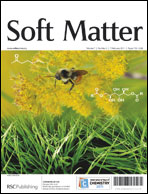Nanoscale visualization and multiscale mechanical implications of bound rubber interphases in rubber–carbon black nanocomposites†
Abstract
The concept of a “bound rubber” phase extending over nanometre-scale distances from the interface of rubber-particle nanocomposites is generally accepted. However, the thickness and elastic properties of this interphase have not been confirmed by direct experimental observation. Here, we demonstrate the existence of bound rubber in hydrogenated nitrile butadiene rubber (HNBR)–carbon black composites, through direct visualization and measurement of elastic properties. Both macro- and nanoscale mechanical analyses show that the bound rubber exhibits an elastic modulus distinct from that of the rubber matrix and of the particles. Direct visualization of this bound rubber viascanning probe microscopy-based approaches requires detailed consideration of potential artifacts in contact-based analysis of viscoelastic nanocomposites. We quantify the magnitude of such contributions, and find that the bound rubber content decreases with increasing temperature, and that its stiffness exceeds that of the rubber matrix by approximately one order of magnitude. Further, the measured thickness and elastic moduli of this bound rubber are consistent with that predicted by our numerical model of a matrix–interphase–particle composite. Together, these experiments and model demonstrate that the elastic properties of nanocomposite interphases of less than 20 nm thickness can be interrogated directly.


 Please wait while we load your content...
Please wait while we load your content...